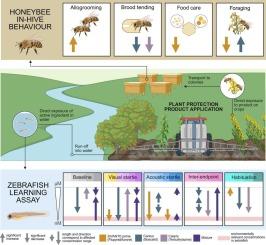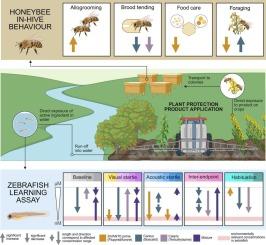Cross-taxa sublethal impacts of plant protection products on honeybee in-hive and zebrafish swimming behaviours at environmentally relevant concentrations
IF 9.7
1区 环境科学与生态学
Q1 ENVIRONMENTAL SCIENCES
引用次数: 0
Abstract
Single and mixture exposure to plant protection products (PPPs) can affect non-target organisms at sublethal concentrations, yet the ecological relevance of behavioural effects remains underexplored. Behavioural disruptions can compromise survival and fitness, with exposure occurring across terrestrial and aquatic ecosystems. Here, we assess the behavioural impact of environmentally relevant PPP concentrations on two ecologically and toxicologically important model species: honeybees (Apis mellifera) and zebrafish (Danio rerio). These organisms represent distinct exposure pathways: pollinator-specific routes such as oral uptake of contaminated nectar and pollen or contact during overspray and foraging, and freshwater contamination via runoff. In honeybees, in-hive behaviours were monitored using a snapshot method from days three to ten after exposure, while zebrafish behavioural endpoints were quantified using a 26-endpoint visual and acoustic motor response (VAMR) assay. Sublethal PPP exposure (1.99–7.81 ng/µL in honeybee hives, 0.0253–27.5 ng/µL in zebrafish assay) caused significant, substance-specific behavioural alterations. In honeybees, flupyradifurone (SIVANTO® prime) significantly decreased foraging and nectar processing, while boscalid (Cantus®) and terbuthylazine (ClickPro®) minimised brood-tending behaviours. Insecticides and fungicides affected honeybees most, while zebrafish embryos were especially sensitive to the herbicide terbuthylazine. They exhibited concentration-dependent neurotoxic phenotypes, with behavioural profiles of the PPPs mixture (consistent with concentrations in German streams: 41.54 % boscalid, 0.013 % flupyradifurone, 58.45 % terbuthylazine) shifting along a terbuthylazine–boscalid gradient. These findings show that PPPs can elicit pronounced behavioural changes in non-target species, even at low environmental concentrations. These results support incorporating in-hive and early-life stage behavioural assays into pesticide risk assessments and warrant mechanistic studies on PPP-induced neurotoxicity.


植物保护产品在环境相关浓度下对蜂巢内蜜蜂和斑马鱼游泳行为的跨分类亚致死影响
单一和混合暴露于植物保护产品(PPPs)可影响亚致死浓度的非目标生物,但行为效应的生态相关性仍未得到充分探讨。行为紊乱会损害生存和健康,暴露在陆地和水生生态系统中。在这里,我们评估了环境相关的PPP浓度对两种生态和毒理学上重要的模式物种的行为影响:蜜蜂(Apis mellifera)和斑马鱼(Danio rerio)。这些生物代表了不同的暴露途径:传粉媒介特有的途径,如口服摄入受污染的花蜜和花粉,或在过度喷洒和觅食期间接触,以及通过径流污染淡水。在暴露后的第3天至第10天,使用快照方法监测蜜蜂的蜂巢内行为,而斑马鱼的行为端点则使用26个端点的视觉和声学运动反应(VAMR)试验进行量化。亚致死PPP暴露(蜂箱中为1.99-7.81 ng/µL,斑马鱼中为0.0253-27.5 ng/µL)导致显著的物质特异性行为改变。在蜜蜂中,氟吡地黄酮(SIVANTO®prime)显著减少了觅食和花蜜加工,而boscalid (Cantus®)和terbuthylazine (ClickPro®)减少了抚育行为。杀虫剂和杀菌剂对蜜蜂的影响最大,而斑马鱼胚胎对除草剂terbuthylazine尤为敏感。它们表现出浓度依赖的神经毒性表型,PPPs混合物的行为特征(与德国河流中的浓度一致:41.54 % boscalid, 0.013 %氟吡地酮,58.45 % terbuthylazine)沿着terbuthylazine - boscalid梯度移动。这些发现表明,即使在低环境浓度下,ppp也能引起非目标物种的明显行为变化。这些结果支持将蜂巢内和生命早期行为分析纳入农药风险评估,并支持对ppp诱导的神经毒性进行机制研究。
本文章由计算机程序翻译,如有差异,请以英文原文为准。
求助全文
约1分钟内获得全文
求助全文
来源期刊

Environment International
环境科学-环境科学
CiteScore
21.90
自引率
3.40%
发文量
734
审稿时长
2.8 months
期刊介绍:
Environmental Health publishes manuscripts focusing on critical aspects of environmental and occupational medicine, including studies in toxicology and epidemiology, to illuminate the human health implications of exposure to environmental hazards. The journal adopts an open-access model and practices open peer review.
It caters to scientists and practitioners across all environmental science domains, directly or indirectly impacting human health and well-being. With a commitment to enhancing the prevention of environmentally-related health risks, Environmental Health serves as a public health journal for the community and scientists engaged in matters of public health significance concerning the environment.
 求助内容:
求助内容: 应助结果提醒方式:
应助结果提醒方式:


